

A B C D E F G H I J K L M N O P Q R S T U V W X Y Z
|
Page 1: Table Football - Target Renegade Page 2: Targhan - Teenage Queen Page 3: Tempest - Terres et Conquérants Page 4: Terrormolinos - Think! Page 5: Thomas the Tank Engine - 3D Snooker Page 6: 3D Starfighter - Thunderbirds Page 7: Thunder Blade - Tintin on the Moon |
Page 8: The Tiny Skweeks - Tomcat Page 9: Toobin' - Track and Field Page 10: Tracksuit Manager - Trashman Page 11: Treasure Island Dizzy - Troglo Page 12: Troll - Turbo Girl Page 13: Turbo Kart Racer - Twinworld Page 14: 2 Player Super League - Typhoon |
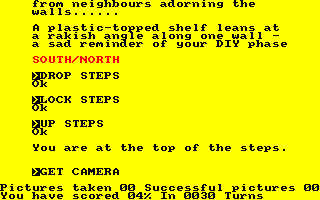 |
Terrormolinos
(Melbourne House, 1985) You've booked a two-week package holiday to the Spanish resort of Terrormolinos with your family – but as you may have guessed, it's going to be the holiday from hell! You must first dash around the house and pack your suitcase with everything you need before you head to the airport. Once you're in Spain, you must take ten photographs of your stay to prove to your friends back home that you survived. This is a text adventure which turns out to be fairly easy to progress in, despite the rather limited parser. The pictures that are displayed are quite humorous, but they are very crudely drawn indeed and look like your CPC has become a Spectrum! The numerous game-ending mishaps that can happen to you also become quite frustrating and spoil what could have been a great adventure. 7 |
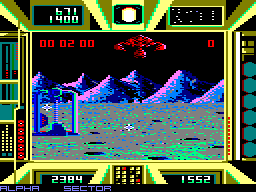 |
The planet Colian is a desolate place that is rich in vital metals, minerals and gemstones. The empire has several bases upon the surface that the Federation is not happy about. Thus, you have been sent to destroy these bases in your Defence Strategy Vehicle. Scattered along the planet's surface are various buildings; some offer power-ups while others recharge your vehicle. Deadly Terrorpods patrol and defend the area and can be very difficult to destroy. There are a lot of controls to master in this strategy/shoot-'em-up game which will put a lot of people off. The graphics look good and move with a very impressive 3D effect that's let down by the sluggish frame rate. Targeting is a hit and miss affair that quickly becomes frustrating to the point where you're no longer bothered about your mission. 5 |
 |
It's the game that helped to sell huge numbers of Nintendo Gameboys, and everyone knows how to play it; make full rows of blocks by slotting together pieces which fall from the top of the screen. Unfortunately, this version doesn't fare well at all; the graphics are garish, and the striped background is confusing. Add some terrible music and clumsy controls which can't be redefined, and you don't get a fun game. Thankfully, there are far better versions in the public domain. 5 |
 |
The forces of the underworld must be defeated by the mighty dragon, Thanatos the Destroyer. It's not often that you get the chance to play a dragon in a computer game. However, in order to complete your mission, you must first find and collect the beautiful sorceress Eros, and then fly onwards to find her spell book, and finally, fly to her cauldron where the spell can be cast. These are all to be found in locked castles, but the wooden entrance door can be burnt down. Your supply of fire is limited, and can be replenished by landing next to a witch, grabbing the knight from his horse and killing him, then eating the witch! There are many other unique things about this game; the parallax scrolling and animation of the dragon and the many opponents you can face are stunning, and the eight skill levels add a lot of replay value to this fantastic game. 9 |
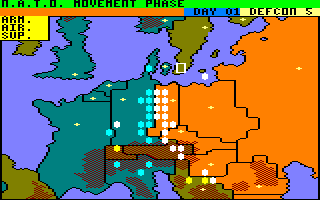 |
This is a wargame taking place during the Cold War era. You can choose your side (NATO or the Warsaw Pact) and the difficulty level. Then you move your units on a map representing Europe (which is really well drawn, by the way). When you select a battle, the screen turns into a little arcade game where you must shoot tanks and aircraft. It doesn't have a big influence on the results of the battles, however. At a certain point of the campaign, you can decide to use chemical or nuclear weapons, but this will often result in the complete destruction of the planet, so think twice before using them! A good, although a bit too repetitive, strategic game. 6 |
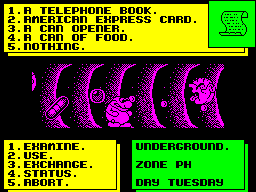 |
Thing!
(Players, 1988) Thing has been assigned to deliver The Ball to the Dingalinger Overlord. However, Thing must complete ten tasks before he is allowed to meet the Overlord. That's definitely one of the weirdest plots I've heard for a game! The planet that Thing wanders is divided into 26 zones which he can teleport between using a telephone box. There are lots of objects scattered over these zones, and it's up to you to discover which ones are used to complete tasks – but you are not informed when you have completed any! You must also avoid contact with the bouncing gargoyles which will cost you one of your five lives. The graphics tell you instantly that this game is a Spectrum port, and Thing moves at such a snail-like pace that the aim of the game seems to be to try to stay awake. 3 |
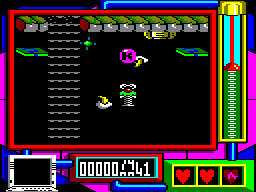 |
Thing is on a mission to locate parts of a computer program which will stop the production of evil toys that the factory he's in is churning out. Now this is no easy task, as not only is the game immense, and not only are there typically weird bad guys everywhere, but also Thing, only being able to jump, is one of the hardest game characters ever to control! On the plus side, though, the graphics are great – lots of detail and very colourful, and Thing is a cute little guy – and the sound is OK too; nothing great, but serviceable. In fact, the game is way above average; it's just so hard! But just suspend the belief that you'll ever finish it, and you'll find a pretty fun game here. It's got everything a platform gamer could desire. See also: Thing on a Spring. 8 |
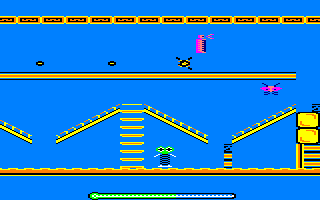 |
The evil Goblin is causing chaos by casting spells and banishing the Earth's treasures to his underground lair. Only one thing can break the spell – completing a magical jigsaw – and only one hero can do the job – Thing on a Spring! Great... I guess we can kiss the Earth's treasures goodbye then. Joking aside, though, this game is seriously frustrating. Not only are the jigsaw pieces scattered around in some of the most out-of-the-way corners of the Goblin's lair, but Thing has one of the hardest-to-control jumps in gaming history. Add to this the large number of seemingly unavoidable enemies and the many instances where you get stuck with no way of progressing, and you have a seriously annoying game. There's a great catchy tune, but the sequel is an improvement in every way. See also: Thing Bounces Back. 4 |
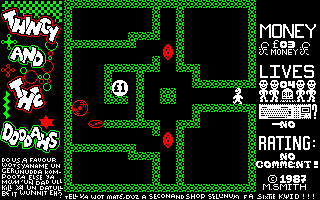 |
Thingy and the Doodahs
(Silverbird, 1987) You've been told to go down to the second-hand shop and find £60 to buy a computer. Starting in your own bedroom, you search the house collecting £1 coins and avoiding the enemies that wander about the rooms. Then it's off into the garden and the forest, through to more sets of mazes, more coins to collect, and more enemies to avoid. It's a really simple kind of game with awful graphics that look as though it's written in BASIC (although it isn't), and the less said about the tune, the better. It's a game that will only be remembered for its extremely silly name. 3 |
 |
This is a board game for two players using a 6×6 grid. Each player must try to align four of their counters in a row either horizontally, vertically or diagonally. However, instead of placing counters on to any tile, a counter must be pushed on to one of the squares at the bottom or right of the board, and all the other counters in that row or column are shifted upwards or to the left as appropriate. The rules are very simple, but it makes for an extremely challenging game which requires a lot of thinking – hence the name. There are several different modes of play, including a tutorial mode and several problem-solving puzzles in which the board is already laid out for you. This is an excellent game for the intellectuals out there. 8 |